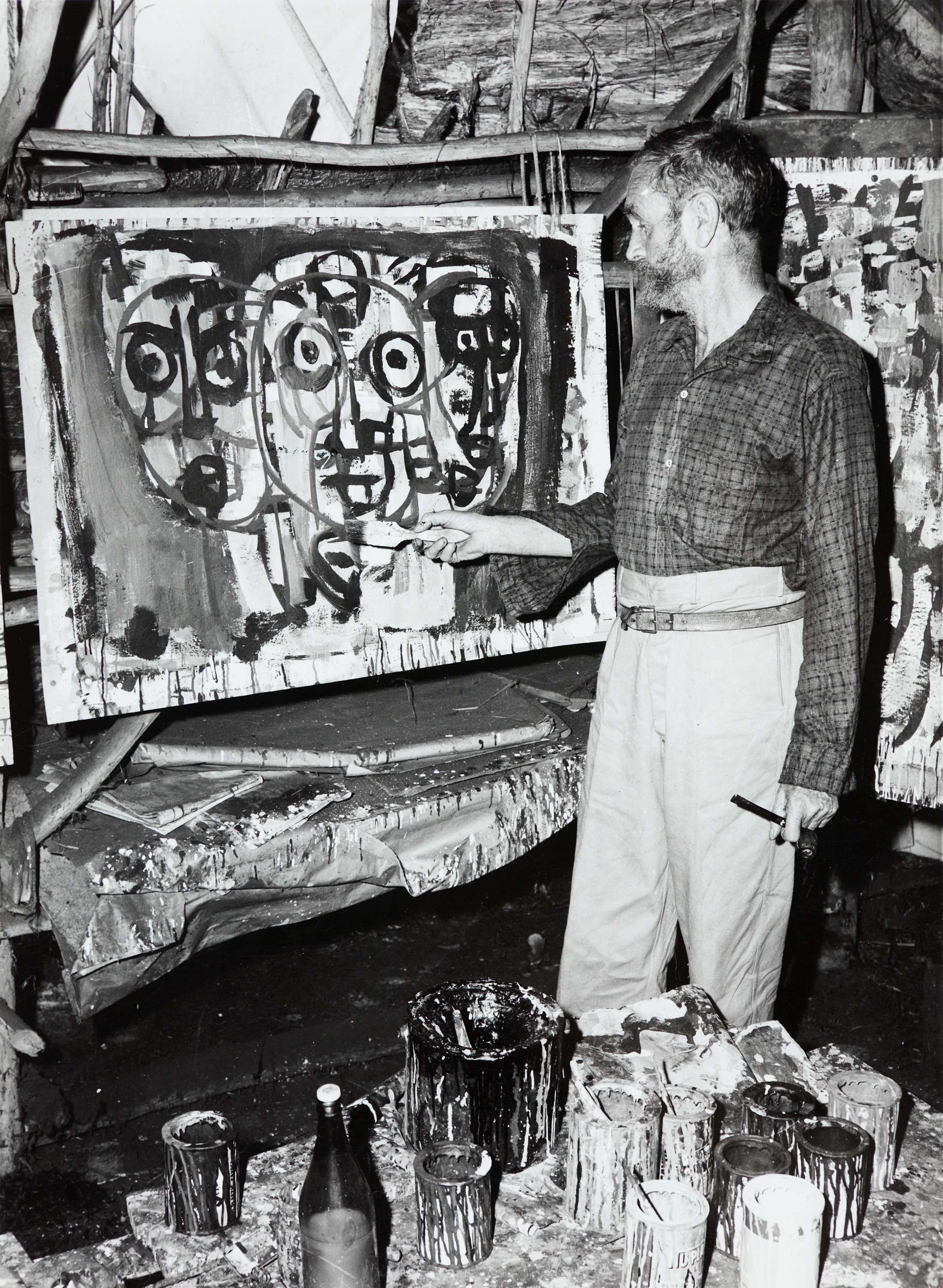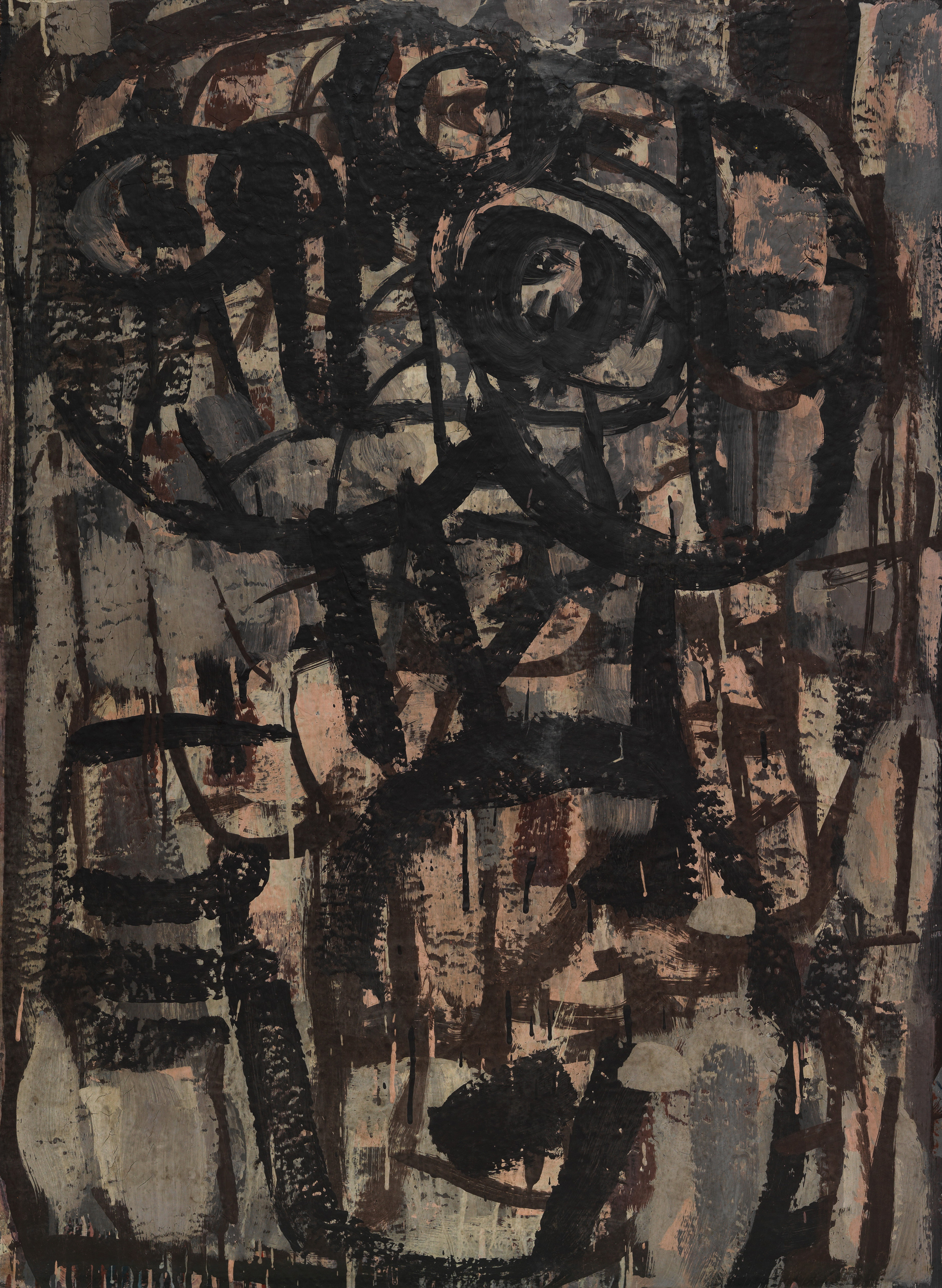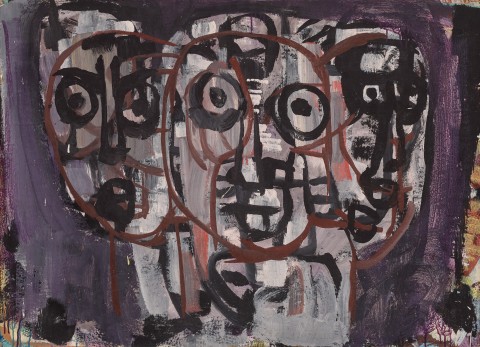NIGHT LIFE, 1962
IAN FAIRWEATHER
synthetic polymer paint and gouache on cardboard on composition board
66.0 x 92.0 cm
bears inscription verso: NIGHT LIFE / “NIGHT LIFE” / BY IAN FAIRWEATHER
Treania Smith (Mrs Clive Bennett), Sydney, 1963
Jack and Beryl Kohane, Melbourne
Niagara Galleries, Melbourne
Norman Rosenblatt, Melbourne, acquired from the above
Niagara Galleries, Melbourne
The Reg Grundy AC OBE and Joy Chambers–Grundy Collection, acquired from the above in 1989 (stamped and label attached verso)
Ian Fairweather, Macquarie Galleries, Sydney, 15 – 27 August 1962, cat. 7
VII Bienal de São Paulo, Parque Ibirapuera, São Paulo, Brazil, 28 September – 22 December 1963, cat. 10 (label attached verso, as ‘Vida Nocturna’)
Fairweather: A Retrospective Exhibition, Queensland Art Gallery, Brisbane, 3 June – 4 July 1965; Art Gallery of New South Wales, Sydney, 21 July – 22 August 1965; National Gallery of Victoria, Melbourne, 9 September – 10 October 1965; National Gallery of South Australia, Adelaide, 26 October – 21 November 1965; Art Gallery of Western Australia, Perth, 9 December 1965 – 16 January 1966; Tasmanian Museum and Art Gallery, Hobart, 10 February – 13 March 1966, cat. 56 (label attached verso)
Hetherington, J., ‘Ian Fairweather: Gentle Nomad who Lives a Lonely Life’, The Age, Melbourne, 9 June 1962, p. 17 (illus.)
Melbourne Herald, Melbourne, 16 August 1962, p. 6
‘Gentle artist’s choice of nomad lonely life’, Sydney Morning Herald, Sydney, 16 August 1962, p. 2
‘The Hermit Painter Hits the Jackpot’, Sun–Herald, Sydney, 19 August 1962, p. 43
Thomas, D., ’Australia’, VII Bienal de São Paulo, Parque Ibirapuera, São Paulo, Brazil, 1963, pl. 4, pp. 53 – 55
‘Ian Fairweather’s Bridge of Sighs’, Sydney Morning Herald, Sydney, 9 September 1965, p. 1 (illus.)
Thomas, L., ‘Hand of a Master: From Complexity to Seeming Simplicity’, The Bulletin, Sydney, 4 December 1965, vol. 87, no. 4475, p. 41 (illus.)
McGregor, C. (et. al), Australian Art and Artists – In the Making, Thomas Nelson, Melbourne, 1969, p. 150 (illus.)
Abbott–Smith, N., Ian Fairweather, A Profile of a Painter, University of Queensland Press, Brisbane, 1974, p. 136
Bail, M., Ian Fairweather, Bay Books, Sydney, 1981, cat. 176, pl. 96, pp. 180, 183 (illus.), 186, 208, 246
Bail, M., Fairweather, Murdoch Books, Sydney, 2009, pp. 179 – 180 (illus.), 194, 224
Roberts, C. and Thompson, J., Ian Fairweather. A Life in Letters, Text Publishing, Melbourne, 2019, pp. 296, 298
IAN FAIRWEATHER, NIGHT LIFE, 1962

Bribie Island, photographer unknown
While we are familiar with people queuing all night to secure Grand Final tickets or front row seats at a rock concert, the idea of camping out overnight in order to be among the first to buy a contemporary painting comes as something of a surprise. When Ian Fairweather’s exhibition opened at the Macquarie Galleries, Sydney in August 1962 however, that is just what happened. Among the group of determined collectors who waited outside the gallery in driving rain was the art critic, Robert Hughes, who bought Monsoon, 1961 – 62 – later acquired by the Art Gallery of Western Australia – describing it as ‘a pure example of ecstatic motion.’1 The Sydney Morning Herald headline hailed Fairweather as ‘Our Greatest Painter’ and more than half of the sixteen paintings in the show were acquired for public collections, including Epiphany, 1961 – 62 (Queensland Art Gallery/Gallery of Modern Art); Mangrove, 1961 – 62 (Art Gallery of South Australia); and Shalimar, 1961 – 62 (National Gallery of Australia), which was purchased for the then developing national collection. Night Life, 1962, was bought by Treania Smith, who ran Macquarie Galleries with Mary Turner, and was both an enthusiastic and perceptive collector.2
Fairweather had settled on Bribie Island, off the coast of Queensland, in mid-1953, and lived there in a pair of self-built huts for the rest of his life. The relative contentment he found in this environment was reflected in his artistic output and the following two decades witnessed the production of many of his finest paintings. The critical and commercial success of the 1962 exhibition built on the momentum that had been growing for some years, and that decade saw his art acknowledged in significant ways. Works were included in the landmark exhibition Recent Australian Painting at the Whitechapel Gallery, London (1961), and the European tour of Australian Painting Today (1964 – 65), and in 1965, a major travelling retrospective of his work – which included the painting on offer here – was mounted by the Queensland Art Gallery. Fairweather obviously regarded Night Life highly, selecting it as one of three works, alongside Shalimar and Portrait of the Artist, 1961 – 62 (National Gallery of Australia), with which he represented Australia at the VII Bienial de São Paulo in 1963.
IAN FAIRWEATHER THE SISTERS

on cardboard on composition board
Gallery of Modern Art, Brisbane
A 1962 photograph of Fairweather in his studio hut – pipe in one hand, paintbrush in the other – shows the artist adding the finishing touches to Night Life. The painting is tacked up on a rudimentary, handmade easel, and a collection of paint tins, each of them open and with paint brushes at the ready, sits on a nearby table. The photograph tells us something about the speed and spontaneity with which he worked, and shot in black and white, it also emphasises the strong linear quality which defines the image of three large heads staring out at the viewer. The subject of this work links it to other contemporary paintings such as The Sisters, 1961 – 62 (Queensland Art Gallery/Gallery of Modern Art) and the self-portrait of the same year, although in these works Fairweather’s dynamic gestural approach competes against pictorial representation, and a stronger sense of abstraction prevails.
1. Bail, M., Fairweather, Murdoch Books, Millers Point, 2009, p. 176
2. For further information about the response to the exhibition see Bail, ibid., p. 194
KIRSTY GRANT
